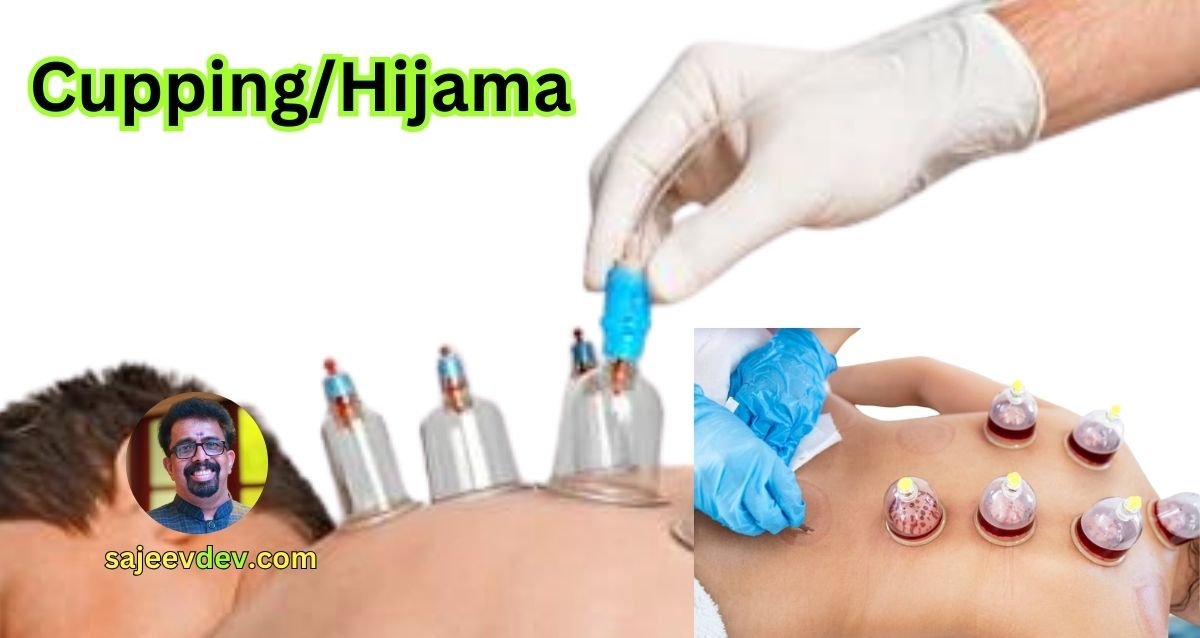Cupping Therapy/Hijama
Cupping therapy, a technique with roots in ancient medical traditions, involves creating suction on the skin using specially designed cups. This practice, believed to enhance blood flow and facilitate healing, has been integrated into various medical systems across different cultures, including Traditional Chinese Medicine and Middle Eastern therapies. The core principle behind cupping is the reduction of stagnation and the facilitation of energy (Qi) or blood flow within the body to promote overall well-being and alleviate specific ailments.
In recent years, cupping therapy has seen a resurgence in popularity, particularly among high-profile celebrities and athletes. The most notable example is Olympic swimmer Michael Phelps, whose visible cupping marks during the 2016 Rio Olympics reignited global interest in this ancient practice. Such prominent public displays have contributed significantly to cupping therapy entering mainstream consciousness, inspiring curiosity and debate among practitioners and the general public alike.
While its visibility has undoubtedly increased, the practice of cupping is far from new. Historians trace its origins back to ancient Egypt, China, and the Middle East. Despite this long history, cupping therapy has always been surrounded by a blend of anecdotal claims about its benefits and a quest for scientific validation. As we explore cupping therapy further, it is essential to consider the historical context, cultural roots, and the broad spectrum of testimonials versus empirical evidence regarding its efficacy.
This introduction merely scratches the surface of the multi-faceted subject that is cupping therapy. In the sections that follow, we will delve deeper into its cultural origins, scrutinize the purported health benefits, examine scientific studies that have investigated its effectiveness, and address potential safety concerns. This comprehensive overview aims to equip readers with a balanced understanding of cupping therapy, facilitating informed opinions and decisions about this intriguing practice.
Historical and Cultural Background
Cupping therapy, an alternative medicinal practice gaining renewed interest in contemporary wellness circles, has roots that trace back to ancient civilizations. Notably practiced in regions such as China, Egypt, the Middle East, and parts of Europe and Latin America, cupping has played a significant role in various traditional healing systems.
Ancient Egyptian medical documents, such as the Ebers Papyrus dating back to 1550 BCE, provide some of the earliest references to cupping therapy. Egyptians utilized this method as a means to purify the body and expel toxins. In the Middle East, cupping is prominently featured in traditional Islamic medicine, also known as Hijama, which integrates prophetic teachings and herbal remedies. Wet cupping or “Hijama” involves making small incisions on the skin before applying the cups, believed to help cleanse the body of impurities and balance bodily fluids.
In Traditional Chinese Medicine (TCM), cupping is regarded as a technique to harmonize the flow of qi (vital life energy). The practice involves creating suction in glass, bamboo, or silicone cups, which are then placed on specific acupuncture points on the body. This suction is thought to stimulate blood flow, remove heat and toxins, and alleviate pain. The concepts of balancing yin and yang and ensuring the smooth flow of qi are central to TCM, with cupping serving as a vital tool for these ends.
In Europe, cupping appeared prominently during the Renaissance and was adopted in various forms, ranging from bloodletting to therapeutic massage. Across Latin America, this technique has been integrated with traditional medicine to address ailments ranging from muscular pain to respiratory issues.
The enduring presence of cupping therapy across such diverse cultures underscores its perceived efficacy and adaptability. By examining these historical and cultural contexts, one gains a more comprehensive understanding of how cupping has evolved and its continued relevance in modern therapeutic practices.
Types of Cupping Therapy
Cupping therapy encompasses a diverse array of methods, each distinguished by its cup material and suction technique. The principal types include dry cupping, wet cupping, fire cupping, and contemporary methods utilizing mechanical pumps.
Dry cupping is the most straightforward form, where cups are placed on the skin to create a vacuum without any incisions. This suction is generally achieved using glass or silicone cups, which adhere to the skin simply through the removal of air.
Conversely, wet cupping, or Hijama, involves a combination of dry cupping and controlled medicinal bleeding. This process begins similarly to dry cupping, but after forming the initial suction, small, superficial incisions are made on the cupped area of skin. The cup is then reattached to draw out a small amount of blood—a practice believed by some to eliminate toxins.
Fire cupping, a traditional technique, uses heat to create suction. Practitioners ignite a small flame within a glass or bamboo cup, thereby heating the air and creating a vacuum when the flame dies out and the cup is quickly applied to the skin. The cooling air inside the cup contracts, forming a tight seal.
Modern mechanical cupping employs sophisticated devices to generate consistent suction, eliminating the need for heat. These mechanical pumps are often attached to silicone or plastic cups, providing a more controlled and adjustable vacuum. This method is increasingly favored in therapeutic and clinical environments due to its precision and ease of use.
The materials for cupping vessels vary significantly, from traditional bamboo and glass to modern silicone. Each material offers distinct advantages: bamboo is lightweight and natural, glass provides visibility and reliable suction, and silicone offers flexibility and ease of cleaning.
Understanding these diverse methods and materials illuminates the multifaceted nature of cupping therapy practiced around the world today. Each type offers unique benefits, tailored to specific therapeutic needs and cultural practices, which underscores the adaptability and enduring appeal of this ancient healing art.
Claims and Uses of Cupping Therapy
Cupping therapy has garnered attention for its wide range of purported health benefits, attracting both traditional practitioners and modern health enthusiasts. One of the most common claims is its effectiveness in relieving musculoskeletal pain. Advocates argue that cupping can address issues such as back pain, neck pain, and joint stiffness by reducing inflammation and enhancing blood flow to the affected areas.
Moreover, cupping therapy is frequently recommended for individuals suffering from fever and poor digestion. Proponents assert that the suction created during cupping helps expel toxins and stagnant blood from the body, potentially leading to improved digestive function and lower incidences of gastrointestinal concerns.
High blood pressure is another condition for which cupping therapy is often suggested. Some practitioners believe that the technique can facilitate the reduction of hypertension by promoting relaxation and alleviating stress, although robust scientific evidence supporting this claim is limited.
In the realm of dermatology, cupping has been cited as a treatment for various skin-related issues, including acne, psoriasis, and eczema. The method is thought to enhance circulation and promote healthier skin by eliminating toxins and stimulating the lymphatic system.
Respiratory conditions, such as asthma and chronic bronchitis, are also among the ailments that practitioners claim cupping can alleviate. The therapy is believed to help clear lung congestion and improve breathing by mobilizing phlegm and other blockages.
Fertility issues are yet another area where cupping therapy is purported to be beneficial. Some practitioners suggest that regular cupping sessions can balance hormonal levels and improve reproductive health, potentially aiding in the treatment of infertility.
Beyond specific medical conditions, many people turn to cupping therapy for general well-being, seeking benefits such as detoxification and improved circulation. The practice is considered by some to boost overall energy levels and enhance vitality. In recent years, cupping has found a place in sports medicine, with athletes using it to alleviate muscle soreness and expedite recovery. Prominent sports figures have been seen with the characteristic circular marks, bringing increased visibility and interest to the practice within the athletic community.
Scientific Evaluation and Criticism
The scientific community has rigorously examined cupping therapy, resulting in significant critique and skepticism regarding its efficacy. Several systematic reviews and studies have assessed the claims made by proponents of cupping therapy and found a lack of robust evidence to support its benefits. A common critique hinges on the methodological weaknesses in many of these studies—ranging from small sample sizes to inadequate control groups and biases in reporting outcomes.
For instance, the American Cancer Society has evaluated cupping therapy and noted that the scientific evidence available does not support its effectiveness for treating any medical condition. Their position aligns with findings from a range of systematic reviews that have scrutinized the available research. These reviews highlight that many studies on cupping therapy suffer from poor design and low reliability, thereby limiting their validity and applicability in a clinical context.
Beyond questioning the general efficacy of cupping, scientists have also addressed specific claims, such as detoxification and improvement in blood flow. The concept of detoxification as proposed by cupping advocates lacks scientific backing. Modern medical science does not recognize the need for external detoxification methods, as the human body is inherently equipped with organs like the liver and kidneys to efficiently eliminate toxins. Furthermore, claims that cupping enhances blood flow and thus leads to healing are unsupported by credible physiological evidence. Researchers argue that any perceived improvement in conditions treated with cupping might, in fact, be attributable to the placebo effect rather than any direct therapeutic action performed by the therapy itself.
In conclusion, while cupping therapy is popular in alternative medicine circles, the scientific evaluation reveals substantial flaws in existing research. This ongoing scrutiny raises questions about the legitimacy of the claimed health benefits and reinforces the necessity for well-designed, large-scale studies to substantiate or refute the efficacy of cupping therapy rigorously.
Safety Concerns and Risks
Cupping therapy, while often touted for its therapeutic benefits, is not without its potential side effects and risks. Among the most common adverse effects are bruising and skin discoloration. These phenomena occur as a result of suction pulling blood vessels to the surface of the skin, leaving noticeable marks that can last for several days. Pain at the cupping site is another frequently reported side effect, which can range from mild discomfort to severe pain, depending on the duration and intensity of the suction applied.
More severe risks associated with cupping therapy include infection, scarring, and burns. Particularly with wet cupping, where the skin is intentionally lacerated before cups are applied, the risk of infection is significantly heightened. The open wounds can become entry points for bacteria, leading to infections that may require medical attention. Scarring is also a consideration, especially for those with sensitive or easily damaged skin. Burns can arise from the use of heated suction cups, which, if not properly controlled, can cause thermal injuries.
Health organizations and regulatory bodies have issued warnings regarding the application and expertise required for performing cupping therapy. It is essential for practitioners to maintain stringent hygiene standards and be adequately trained to minimize these risks. Additionally, the instruments used must be sterile to prevent cross-contamination and subsequent infections.
Legal complications can emerge as well, particularly when cupping marks are mistaken for signs of physical abuse. These marks can be misinterpreted by medical professionals, social workers, or law enforcement, leading to unfounded accusations and investigations. Awareness and documentation of the procedure can mitigate these risks, ensuring that all parties understand the origins of the cupping marks.
In conclusion, while cupping therapy presents various therapeutic claims, it is pivotal for individuals to be aware of the associated safety concerns and risks. Adequate training for practitioners and clear communication with clients are essential in minimizing potential adverse effects and ensuring a safe therapeutic experience.
Current Popularity and Cultural Significance
Cupping therapy has experienced a resurgence in popularity in recent years, driven by its integration into both ancient cultural practices and contemporary wellness trends. Its appeal lies in the fusion of traditional healing methods with modern alternative medicine, offering a holistic approach that resonates with a diverse audience seeking various wellness solutions. This ancient practice, rooted in traditional Chinese medicine, has managed to penetrate mainstream culture, making it a notable element in the current landscape of health and wellness.
One of the key factors contributing to the modern popularity of cupping therapy is its endorsement by high-profile athletes and celebrities. These endorsements have played a significant role in elevating public awareness and acceptance of the therapy. For instance, the visible cupping marks on the backs of Olympic athletes like Michael Phelps during the 2016 Rio Olympics brought the practice into the spotlight, sparking widespread interest and curiosity.
Additionally, the rise of social media has further amplified the visibility of cupping therapy. Platforms like Instagram and Twitter are replete with posts from influencers and wellness enthusiasts sharing their cupping experiences, often highlighting the perceived benefits such as pain relief, muscle recovery, and relaxation. This not only normalizes the practice but also embeds it into the fabric of current health and fitness dialogue, drawing a new generation of followers to the ancient therapy.
Beyond the celebrity and social media hype, cupping therapy’s cultural significance is deeply rooted in various traditional practices. In Middle Eastern cultures, for example, cupping (referred to as “hijama”) is a well-established therapeutic procedure used to maintain health and treat ailments. Similarly, in certain parts of Europe and Latin America, traditional versions of cupping are still practiced, blending cultural heritage with modern health regimens.
The ongoing interest in holistic health and natural remedies also fuels the popularity of cupping therapy. As people become increasingly wary of pharmaceutical interventions and look for more natural ways to manage their health, therapies like cupping—promising holistic healing and wellness—gain traction. This trend aligns with the broader movement towards integrative medicine, where conventional and alternative therapies coexist to offer comprehensive care.
Recommendations
The examination of cupping therapy elucidates a complex narrative, encapsulating both historical and contemporary perspectives. The practice, with origins tracing back to ancient cultures, persists in modern times despite ongoing debate within the medical community. Advocates of cupping therapy herald its purported benefits, ranging from pain relief to enhanced blood flow. However, the scrutiny of cupping therapy through the lens of scientific investigation reveals a significant discrepancy between anecdotal claims and empirical evidence.
Key points discussed include the methodological limitations of existing studies, often characterized by small sample sizes and lack of rigorous controls. These factors contribute to an inconclusive body of evidence, casting doubt on the efficacy of cupping therapy. Furthermore, the analysis highlights potential risks associated with the practice, such as skin infections, burns, and complications arising from poorly sanitized equipment.
This discourse emphasizes the critical importance of consulting with qualified healthcare professionals when exploring alternative therapies like cupping. Decisions regarding health and well-being should be grounded in informed judgment, weighing the potential benefits against the scientifically established risks. As the medical community continues to investigate and refine therapeutic approaches, individuals are encouraged to consider evidence-based treatments and engage in open dialogue with their healthcare providers.
In summary, while cupping therapy remains a topic of intrigue and debate, the current scientific perspective advocates caution. The allure of traditional remedies must be balanced with a commitment to empirical rigor. By prioritizing informed decisions and professional guidance, individuals can navigate the complexities of health care with a focus on safety and efficacy.







